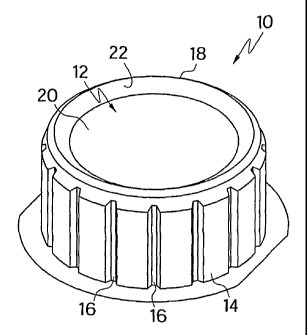Some of the information on this Web page has been provided by external sources. The Government of Canada is not responsible for the accuracy, reliability or currency of the information supplied by external sources. Users wishing to rely upon this information should consult directly with the source of the information. Content provided by external sources is not subject to official languages, privacy and accessibility requirements.
Any discrepancies in the text and image of the Claims and Abstract are due to differing posting times. Text of the Claims and Abstract are posted:
| (12) Patent: | (11) CA 2426788 |
|---|---|
| (54) English Title: | METHOD OF MAKING A CAN HAVING A RECESSED BASE |
| (54) French Title: | PROCEDE DE FABRICATION DE BOITE-BOISSON A BASE RENFONCEE |
| Status: | Deemed expired |
| (51) International Patent Classification (IPC): |
|
|---|---|
| (72) Inventors : |
|
| (73) Owners : |
|
| (71) Applicants : |
|
| (74) Agent: | GOWLING WLG (CANADA) LLP |
| (74) Associate agent: | |
| (45) Issued: | 2007-10-09 |
| (86) PCT Filing Date: | 2001-10-25 |
| (87) Open to Public Inspection: | 2002-05-10 |
| Examination requested: | 2003-12-15 |
| Availability of licence: | N/A |
| (25) Language of filing: | English |
| Patent Cooperation Treaty (PCT): | Yes |
|---|---|
| (86) PCT Filing Number: | PCT/EP2001/012581 |
| (87) International Publication Number: | WO2002/036284 |
| (85) National Entry: | 2003-04-23 |
| (30) Application Priority Data: | ||||||
|---|---|---|---|---|---|---|
|
A method of making a can having a recessed base (12) and, in particular, to a
method of forming a recessed base (12) in can bodies of the type which include
a side wall (14) having flutes or grooves (16) defined therein. A first
forming step creates a preform having a side wall with at least one axially
extending rib formed therein and a base which is coextensive with the side
wall and intersects the side wall at a rim. This first forming step is
performed so that at least a portion of the base is recessed by a
predetermined depth with respect to the rim. The method further includes a
second step which comprises a further drawing operation to form a can body
having a recessed base. It is important that the predetermined depth be
sufficient to prevent any of the axially extending ribs from being drawn into
the recessed base.
La présente invention concerne un procédé de fabrication d'une boîte-boisson à base renfoncée et, en particulier, un procédé de formation d'une base renfoncée dans les corps des boîtes-boisson du type dont la paroi latérale comporte des cannelures ou des rainures. Une première étape de formage sert à créer une avant-forme dont la paroi latérale comporte au moins une nervure venant axialement et dont la base vient dans l'extension de la paroi latérale, coupant la paroi latérale au niveau d'une bordure. Cette première étape de formage s'exécute de façon qu'une partie au moins de la base soit renfoncée d'une profondeur définie par rapport à la bordure. Le procédé comporte ensuite une seconde étape comportant une autre opération de repoussage permettant de former un corps de boîte-boisson dont la base est renfoncée. Il est important que la profondeur définie soit suffisante pour éviter que l'une au moins des nervures venant axialement ne soit repoussée dans la base renfoncée.
Note: Claims are shown in the official language in which they were submitted.
Note: Descriptions are shown in the official language in which they were submitted.

For a clearer understanding of the status of the application/patent presented on this page, the site Disclaimer , as well as the definitions for Patent , Administrative Status , Maintenance Fee and Payment History should be consulted.
| Title | Date |
|---|---|
| Forecasted Issue Date | 2007-10-09 |
| (86) PCT Filing Date | 2001-10-25 |
| (87) PCT Publication Date | 2002-05-10 |
| (85) National Entry | 2003-04-23 |
| Examination Requested | 2003-12-15 |
| (45) Issued | 2007-10-09 |
| Deemed Expired | 2015-10-26 |
There is no abandonment history.
| Fee Type | Anniversary Year | Due Date | Amount Paid | Paid Date |
|---|---|---|---|---|
| Registration of a document - section 124 | $100.00 | 2003-04-23 | ||
| Application Fee | $300.00 | 2003-04-23 | ||
| Maintenance Fee - Application - New Act | 2 | 2003-10-27 | $100.00 | 2003-09-22 |
| Request for Examination | $400.00 | 2003-12-15 | ||
| Maintenance Fee - Application - New Act | 3 | 2004-10-25 | $100.00 | 2004-09-22 |
| Maintenance Fee - Application - New Act | 4 | 2005-10-25 | $100.00 | 2005-09-16 |
| Maintenance Fee - Application - New Act | 5 | 2006-10-25 | $200.00 | 2006-09-20 |
| Final Fee | $300.00 | 2007-07-20 | ||
| Maintenance Fee - Application - New Act | 6 | 2007-10-25 | $200.00 | 2007-09-17 |
| Maintenance Fee - Patent - New Act | 7 | 2008-10-27 | $200.00 | 2008-09-15 |
| Maintenance Fee - Patent - New Act | 8 | 2009-10-26 | $200.00 | 2009-10-08 |
| Maintenance Fee - Patent - New Act | 9 | 2010-10-25 | $200.00 | 2010-10-14 |
| Maintenance Fee - Patent - New Act | 10 | 2011-10-25 | $250.00 | 2011-10-14 |
| Maintenance Fee - Patent - New Act | 11 | 2012-10-25 | $250.00 | 2012-10-11 |
| Maintenance Fee - Patent - New Act | 12 | 2013-10-25 | $250.00 | 2013-10-14 |
Note: Records showing the ownership history in alphabetical order.
| Current Owners on Record |
|---|
| CROWN CORK & SEAL TECHNOLOGIES CORPORATION |
| Past Owners on Record |
|---|
| DERR, BENJAMIN |
| KIRK, WILLIAM A. |